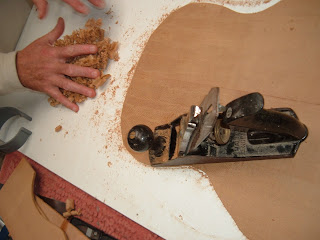
An here's my plan for the bridge, which I briefly mentioned, and glued, in the previous post:



- planing the sides down by 0.00000000000000067mm!!!!
- a Dolphin too fat.
A record of my first attempt at making a guitar, I say first because it's addictive! I already have plans for the next two! This site will show all my mistakes & trials that don't work, & the ones that do. A lot of the books & websites don't cover errors encountered when you don't have all the tools, or the same woods, shapes etc. Hopefully it will help people who are starting out on this path too. Comments appreciated. Happy reading!

An here's my plan for the bridge, which I briefly mentioned, and glued, in the previous post:



- planing the sides down by 0.00000000000000067mm!!!!
- a Dolphin too fat.

Following that, I had the piece of Madagascar Rosewood for the bridge in my hand for some reason, so I said "Why not glue this in the shape I want it!"

- I'll explain later what I'm doing with this piece, and why it's in such an irregular rough shape...
So back to the soundboard.
I Started off work with the top today by tracing a template from the plan I had for the "OOO guitar" I then cut this out and traced around it:

- I should stress at this point you must line up the central line on the template(make sure you trace that too!) with the glued line on the soundboard, this is to keep the grain uniform with the direction of the guitar body. Make sure you stick tape that template to it before you start tracing :)
She went under the saw again for the next step. Leave the cut 3mm proud of the outline:
Be-a-utiful.
The last step for the day was to plane the thickness of the soundboard. It's usually 2-2.5mm for a soundboard. But this is Cedar, which is a softer wood, so 10%-15% is added to that thickness. I hand planed it down to 3mm. It's a little thick still, but I will be sanding down the other side anyway later on in the process. Clamp one end of the board, using a flat piece of scrap wood to avoid clamp marks in the wood.
Here's a couple of pics:


 - and that was it for the day.
- and that was it for the day.





The last thing you do is find a clean flat surface, and lay a strip of wax paper down the same length as the pieces of wood, this is to stop the glue bonding the soundboard to your workbench!
Place a small strip of wood(1-2cm cubed and longer than the pieces of wood) underneath the middle of the soundboard & screw 3 screws in either side to keep up the "Peak" and make it as tight as you can. You'll damage the edges doing this, but you'll be cutting them off pretty soon anyway. It'll look like this:

Holding the sides level, press down along the glued edge until the two boards are flat. WARNING if you had the peak too high you could damage or even break the boards at this point, so be aware of the stress levels in the wood as you're applying pressure.
Finally I placed an old varnished windowsill on top of it, the varnish won't let the glue stick that much to it, and was easy to come off when we removed it the next day. To apply extra weight for the joining process I placed some stones form the garden on top of the windowsill.
24 hours.
24 hours you wait for the glue to dry.
24 hours for any glued joint to dry.
24 hours.
 The grain was amazing, stiff & no blemishes. It really was a mastergrade top.
The grain was amazing, stiff & no blemishes. It really was a mastergrade top.- Please note there is a minimum shipping order of $50.00 from Alaska Woods.
 That's a lot of detail & separate pieces of wood. It's also very fine cuttings on all the Mother of Pearl too.
That's a lot of detail & separate pieces of wood. It's also very fine cuttings on all the Mother of Pearl too. Combining the 2 Stewmac orders would have saved me some shipping too - it pays to make a definitive list of what you need before you order anything. Sometimes the thrill of getting your woods and starting will cause you to forget things you may need further on in the job.
